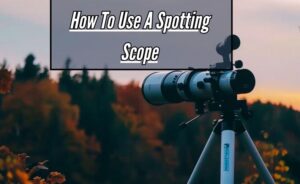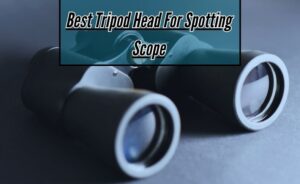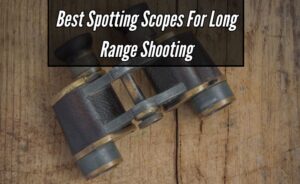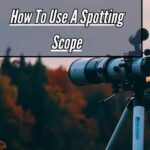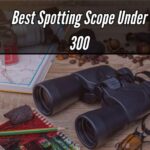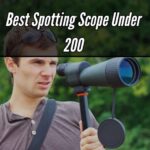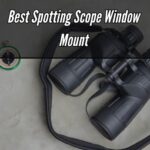A universe of opportunities awaits amateur astronomers and outdoor enthusiasts who investigate the concept of utilizing a telescope as a spotting scope. Although the main functions of the two devices are distinct, it is interesting to know if a telescope may be used as a spotting scope. Determining the interchangeability of the two instruments requires an understanding of their differences and similarities.
Can I Use A Telescope As A Spotting Scope? Yes, there are circumstances in which a telescope can be used as a spotting scope. Spotting scope features like magnification and clarity can also be found in telescopes. The intended usage and design do differ in a few ways, though. Although a telescope can be used for basic spotting, dedicated spotting scopes are designed with features that are specific to the activity, such as larger fields of vision and improved low-light performance.
In this discussion, factors like portability, field of view, and magnification are important. We can understand the potential use of telescopes in spotting scope applications by looking into these characteristics. This investigation broadens our knowledge of optical devices and provides useful information for a variety of pursuits, such as astronomy and birding. Let’s explore this fascinating issue in more detail and see what opportunities it brings.
Telescope vs. Spotting Scope: Unveiling the Key Differences
Although they both include strong optical instruments for studying far-off objects, telescopes and spotting scopes have different functions and features. To choose the best instrument for your particular needs, it is essential to comprehend the differences between them.
Optical Design:
Larger apertures and longer focal lengths allow telescopes to collect light and provide detailed views of celestial bodies; they are mostly used for astronomical observations.
Spot scopes, on the other hand, have broader fields of vision and lower magnifications because they are made for terrestrial viewing purposes, such as birdwatching and scenic observation.
Magnification and Field of View:
Higher magnification capabilities of telescopes enable users to zoom in on far-off objects with more clarity. They are less useful for scanning wide regions, though, because of their reduced field of view due to the higher magnification. Spotting scopes are perfect for monitoring moving objects or studying landscapes because of their lower magnifications, which offer broader fields of view.
Portability and Size:
When compared to telescopes, spotting scopes are typically lighter and more portable, which makes them simpler to set up and carry for outdoor pursuits like hiking and birdwatching.
Telescopes are neither as portable or as convenient to use in remote areas since they are often heavier and require more solid mounts, especially for deep-sky views.
Image Quality and Resolution:
Larger apertures and specially coated surfaces reduce optical aberrations, two aspects that are specifically designed to maximize the resolution of images captured by telescopes of celestial objects.
For terrestrial observations, premium types of spotting scopes can still provide excellent clarity and color fidelity, but their main priorities are durability and versatility above maximum image quality.
Adaptability and Accessories:
In order to tailor their watching experience for various astronomical occurrences, telescopes frequently come with a variety of accessories, including eyepieces, filters, and motorized mounts.
Despite having fewer attachments available, spotting scopes can be used with a range of digiscoping adapters to allow users to take pictures or films via their scopes using smartphones or cameras.
Cost and Affordability:
Spotting scopes are a more cost-effective option for outdoor lovers and amateurs than telescopes, as they are generally less expensive. Telescopes can be more expensive and may need more maintenance and accessory expenditures, especially those with greater apertures or sophisticated features.
Specialized Applications:
Spot scopes are useful for a variety of tasks, including target shooting, wildlife monitoring, surveillance, and even photography, whereas telescopes are mostly employed for astronomical observations.
To select the ideal optical equipment that fits your demands and budget, it is crucial to understand your unique requirements and areas of interest.
Unlocking the Versatility: Adapting Your Telescope for Spotting
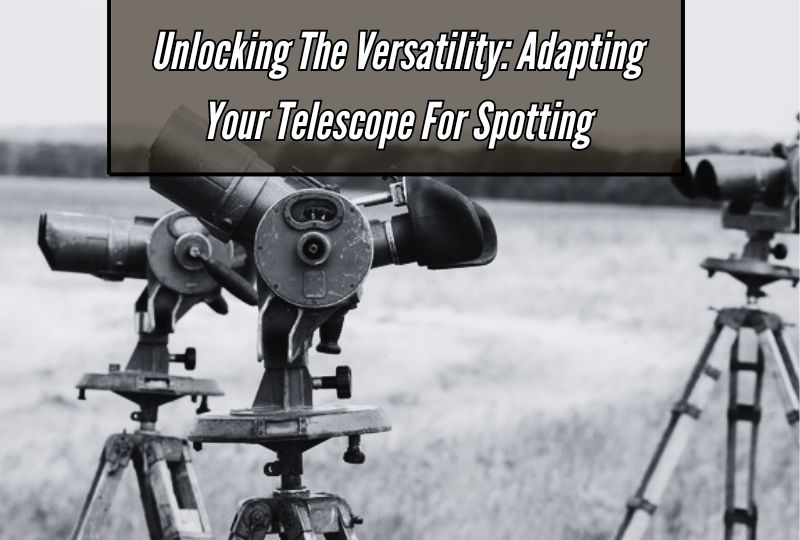
Using a telescope to explore the immensity of the night sky is an exciting and magical experience. But a lot of amateur astronomers just look at celestial objects, such as planets and stars.
Nevertheless, by modifying your telescope for observing different objects on Earth, you might uncover an entire universe of terrestrial treasures that are just waiting to be explored. Let’s explore how you can use your telescope’s adaptability to its full potential.
Understanding Your Telescope’s Capabilities:
Learn about the characteristics of your telescope before attempting to spot terrestrial objects. Its usefulness for terrestrial observation will depend on elements like field of vision, magnification, and aperture size.
Choosing the Right Accessories:
Give your telescope the add-ons you need to increase its versatility for spotting. Prisms for adjusting image orientation, specialized eyepieces for seeing from a wide angle, and mounting brackets for stability during terrestrial observation are a few examples of what this might include.
Calibrating for Terrestrial Viewing:
Calibration is necessary to maximize image stability and clarity while adjusting your telescope for viewing on land. To get the best possible balance between field of view and detail, make sure the lenses are properly aligned and try out various magnifications.
Exploring Terrestrial Targets:
There are many different things to observe in the terrestrial domain, ranging from wildlife and landscapes to architectural wonders. Try experimenting with different focus lengths and settings to get panoramic vistas of your surroundings or fine details of faraway objects.
Overcoming Challenges:
Terrestrial spotting poses distinct problems, such as air distortion, light pollution, and dynamic scenes, in contrast to celestial observation. To acquire the skills necessary to get over these challenges and take sharp, clear pictures, practice and patience are essential.
Adjusting for Atmospheric Conditions:
Your viewing experience might be significantly impacted by atmospheric conditions. Use filters to enhance contrast and clarity in order to adjust to changing environmental factors like temperature, humidity, and air turbulence. Moisture buildup can also be avoided by utilizing anti-dewing treatments and altering the focus of the telescope.
Continued Learning and Experimentation:
Experimentation and ongoing learning are the keys to unlocking the full potential of your telescope. Continue to be inquisitive, experiment with novel methods, and don’t be scared to push the limits of your tools. You’ll learn new techniques for adjusting your telescope to see heavenly treasures if you put in the effort and have patience.
Optimizing Telescopes for Observation: Enhancing Potential for Spotting Scope Use
Telescope observations of planets or other celestial objects have long captivated astronomers, and these devices can be greatly improved for an even more rewarding experience. In this article, we explore several methods to fully utilize spotting scopes and improve their efficacy as observational instruments.
Understanding Optics:
Understanding the fundamentals of optics is essential to optimizing telescopes. Understanding ideas like field of view, magnification, and aperture will help users choose or modify their spotting scopes with greater knowledge and confidence.
Choosing the Right Optics:
It is essential to choose the right optics for a given set of observational requirements. Details like focal length, coating, and lens quality all have a big impact on how bright and clear the observed images are. Purchasing top-notch lenses can significantly improve the viewing experience.
Utilizing Accessories:
Spotting scope capabilities can be improved even further with the help of add-ons such eyepieces, filters, and mounts. Variable magnification eyepieces allow for versatility in viewing a variety of objects, and filters aid in glare reduction and contrast enhancement. Furthermore, steady viewing is ensured by using tripods or solid mounts, especially at greater magnifications.
Optimizing Setup:
For best results, the spotting scope must be set up correctly. This entails making certain the scope is firmly fixed on a sturdy platform and precisely focusing and aligning it. Reducing vibrations and reducing outside light interference can greatly enhance the quality of the images that are detected.
Regular Maintenance:
To ensure optimal performance, spotting scopes need to be maintained on a regular basis, much like any other precision instrument.
Longer equipment life and better image quality are achieved by routinely cleaning lenses and optics, inspecting the apparatus for damage or misalignment, and storing it carefully when not in use.
Continuous Learning:
Finally, to maximize the utilization of telescopes, ongoing research and development are crucial. Over time, enthusiasts can increase their knowledge and sharpen their observational skills by participating in online groups, going to workshops, and trying out various approaches.
Choosing the Right Optics: Balancing Portability and Durability in Telescopes and Spotting Scopes
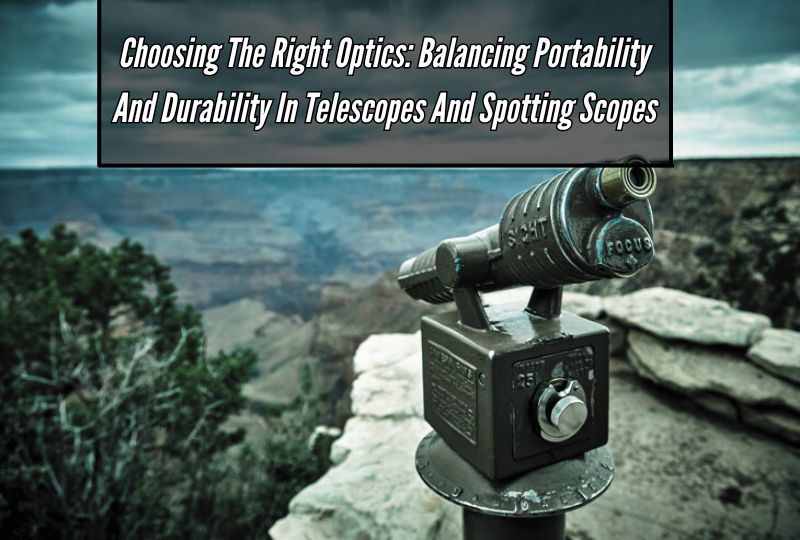
Finding the ideal mix between mobility and durability is essential when choosing the ideal optics for your stargazing or birding excursions. To assist you in making an informed choice, let’s examine a few important factors.
Understanding Your Needs:
Start by determining your unique needs. Do you enjoy watching birds and making observations on land more than you do seeing celestial objects? Knowing what your main purpose is will help you choose the right kind of optics.
Portability:
Select a telescope or spotting scope that balances portability and performance. Better image quality is achieved with bigger apertures, but these lenses are typically heavier and bulkier, which makes them less portable. If portability is important to you, look for small models with lightweight or collapsible construction.
Durability:
Purchasing robust optics will guarantee their lifetime and dependability, particularly if you intend to use them in challenging outdoor conditions.
Shock-absorbing materials, weather-resistant coatings, and robust construction are examples of traits to look for. Furthermore, you should think about getting carrying bags or protective cases to keep your equipment secure while being transported.
Optical Quality:
As optical quality directly affects the sharpness and level of detail in your observations, pay attention to it. Select spotting scopes and telescopes with premium mirrors or lenses, together with coatings that reduce glare and improve light transmission. Sharper visuals and more engaging viewing experiences are the outcome of superior lenses.
Mounting Options:
With your selected optics, take into account the mounting choices available. When monitoring and placing an object precisely, especially when watching astronomical objects, a stable and adjustable mount is necessary.
Select mounting options that include simple adjustment controls and support for add-ons like smartphone mounts or adapters for cameras.
Exploring Technical Specifications:
To learn more about the strengths and weaknesses of various optics, go into their technical details. Consider factors like field of view, magnification range, and aperture size. By allowing you to see each optic’s capabilities and range of use, these characteristics will help you reduce the number of possible choices.
Seeking Expert Advice:
Expert astronomers, ornithologists, and optics aficionados are a great resource for advice. Their personal experiences and knowledge enable them to provide insightful advice and recommendations.
Hiring the advice of others can help you choose the best optics for your needs by providing you with their knowledge, whether through online forums, local clubs, or reputable vendors.
User-Friendly Optics: Ease of Use in Telescopes and Spotting Scopes Compared
When it comes to stargazing and seeing animals, the user experience with telescopes and spotting scopes can be greatly influenced by their ease of use. Let’s examine the subtle differences in usability between spotting scopes and telescopes and explore the nuances of user-friendly optics.
Design and Ergonomics:
Spotting scopes and telescopes are designed differently to meet different purposes. Larger and heavier in nature, telescopes are made for observing celestial bodies; hence, they need steady mounts and exact adjustments.
Spotting scopes, on the other hand, are more lightweight and portable, and they frequently include ergonomic features that make them comfortable to use whether observing wildlife or the terrestrial world.
Ease of Setup and Assembly:
Particularly for novices, setting up a telescope can occasionally be a difficult undertaking. For best viewing, the optics must be aligned, the mount must be balanced, and the settings must be calibrated.
On the other hand, spotting scopes are typically easier to assemble and adjust, which makes them more user-friendly—especially for novice users.
Adjustability and Control:
With the increased magnification powers of telescopes, users can examine celestial objects up close. However, especially for inexperienced users, this increased magnification can occasionally make it difficult to find and follow objects.
Spotting scopes usually have a lower magnification but have more user-friendly controls that enable users to rapidly change the focus and zoom levels for the best viewing experience.
Ease of Target Acquisition:
Target acquisition is fast and simple with spotting scopes; many models come with integrated sighting aids and adjustable zoom for fine focus.
Accurately locating and tracking celestial objects may need greater patience and expertise when using telescopes, especially those used for astronomical observation. However, locating objects with a telescope has gotten easier for novices thanks to computerized mounts and digital sky maps.
User-Friendly Features and Controls:
Numerous functions and controls are included with both telescopes and spotting scopes to improve the user experience. Features like twist-up eyecups, focus wheels that may be adjusted, and rubber armor for comfort and durability are common in spotting scopes.
Telescopes can have user-friendly interfaces for gaining access to internal databases and astronomical data, as well as electronic controls for slewing and tracking celestial objects.
Navigating the Setup: Configuration Differences Between Telescopes and Spotting Scopes
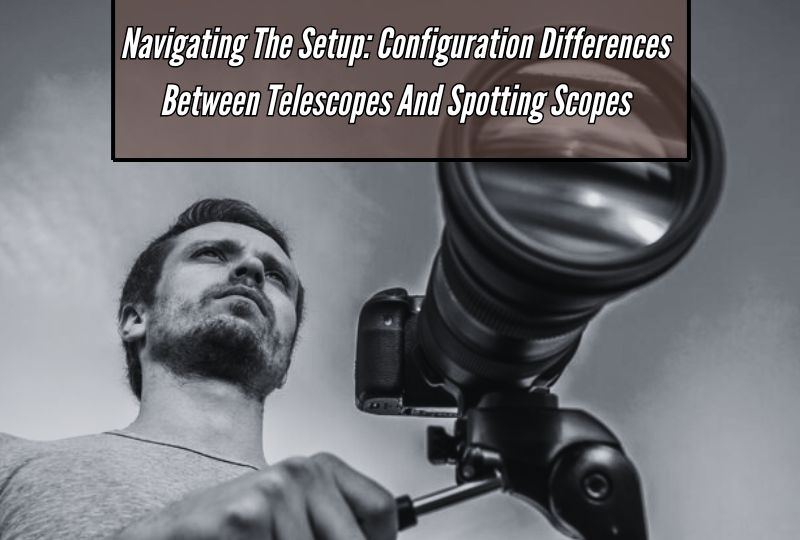
Understanding the Basics
Selecting an appropriate optical instrument is essential when venturing into the cosmos to discover its wonders or viewing creatures far below. Although they are designed differently for different applications, telescopes and spotting scopes have comparable functions.
Optical Design Variations
In order to observe far-off celestial objects like planets, stars, and galaxies, telescopes are generally used for astronomical observations. In order to provide high magnification for in-depth views of objects in the night sky, they usually have a bigger aperture and a longer focal length.
When used for terrestrial viewing activities like birdwatching, hunting, or nature observation, spotting scopes are designed for different purposes. Frequently, they offer brighter, more expansive views with less magnification.
Mounting and Stability
Their mounting mechanisms represent yet another important distinction. In order to precisely monitor celestial objects as the Earth spins, telescopes are typically mounted on equatorial or alt-azimuth mounts.
On the other hand, spotting scopes frequently include lighter and more portable mounts that allow for simple mobility and fast adjustments in the field.
Portability and Size Considerations
Because of their wider apertures and longer focal lengths, telescopes are typically heavier and bulkier, which makes them less practical for outdoor activities or travel.
Spotting scopes are more portable and ideal for on-the-go use, whether hiking in the backcountry or going to sporting events because of their lightweight and small construction.
Eyepieces and Accessories
You may vary the magnification levels of both telescopes and spotting scopes to suit your viewing needs with interchangeable eyepieces. There could be differences between the two, though, in the kinds of eyepieces and accessories.
While spotting scopes may come equipped with built-in sunshades or digiscoping adapters to allow the use of a digital camera for picture capture, telescopes are typically used for astrophotography, which requires specific filters and adapters.
Cost and Accessibility
Because they have more sophisticated optical systems and are designed specifically for astronomical studies, telescopes are typically more expensive. For outdoor enthusiasts and hobbyists looking for adaptable optics for viewing on land, spotting scopes provide a more affordable solution.
Sporting goods stores and outdoor businesses are also more likely to have spotting scopes, making them easily accessible to both novice and experienced users.
Aperture Size and Light Gathering:
The capacity of optical devices to gather light is directly impacted by the size of their apertures. Larger apertures on telescopes allow them to gather more light, which makes it possible to see faint celestial objects more clearly and brightly.
Despite often having smaller apertures, spotting scopes are designed for daytime viewing and offer sharp images of terrestrial objects in a range of illumination situations.
Pros and Cons of Spotting Scope:
Pros:
- Greater magnification is available for observing far-off objects in detail.
- Lighter and often more portable than telescopes.
- With features like angled eyepieces, it was made for viewing on land.
- Features like zoom lenses are frequently included for flexible use in a range of scenarios.
Cons:
- Limited for astronomical viewing compared to telescopes.
- May have a narrower field of view compared to some telescopes.
Pros and Cons of Telescope:
Pros:
- Provides superior optics and larger aperture for better astronomical viewing.
- Capable of higher magnifications for detailed observation of celestial objects.
- Offers a wider field of view, ideal for scanning the night sky.
- Can be used for both terrestrial and astronomical observation with appropriate accessories.
Cons:
- Typically larger, bulkier, and less portable than spotting scopes.
- May require additional accessories or adaptations for terrestrial viewing.
Conclusion
In conclusion, it’s critical to understand the distinctions between the two instruments even if it is possible in some situations to use a telescope as a spotting scope. Telescopes have restricted fields of vision and great magnification since they are made for astronomical gazing. Spotting scopes, on the other hand, have lower magnification and larger fields of vision because they are designed for terrestrial viewing.
Although a telescope can function as an improvised spotting scope, its performance and convenience may be worse. Therefore, for best results when engaging in hobbies such as nature observation, hunting, or birding, it is recommended to get a specialized spotting scope.
Frequently Asked Questions (Can I Use A Telescope As A Spotting Scope)
Can you use a telescope for shooting?
Since telescopes are intended for astronomical observations and distant terrestrial objects, they are rarely used for photography. Specialized gear, such as scopes made for rifles or weapons, is needed for shooting or firearms.
These scopes, which are also known as rifle scopes, are made to endure recoil, provide accurate targeting, and are best used at close to medium ranges. It would not be practicable to try to use a standard telescope for shooting because it would not have the features required for precision, stability, or safety.
Can you use a telescope for bird watching?
Yes, telescopes can be used to observe birds, especially when doing so from a distance or in challenging-to-reach locations. Spotting scopes, or telescopes made for use on the ground, are particularly well suited for bird observation.
By providing magnification, a larger field of view, and greater picture quality than binoculars, these spotting scopes enable bird watchers to study minute features of birds even from a distance. Some spotting scopes can also be connected to cameras, allowing birders to take stunning pictures of their feathered objects.
What are the advantages of using a telescope as a spotting scope?
A telescope can be used as a spotting scope and has various benefits. First of all, telescopes offer strong magnification, making it possible to see far-off objects clearly. Larger objective lenses on them frequently collect more light for improved visibility in low light. Since many models of telescopes may be used for both terrestrial and celestial observations, they also offer versatility.
Their robust design also offers stability for extended viewing. All things considered, telescopes used as spotting scopes improve your capacity to see details in the natural world, wildlife, or celestial bodies, making them useful instruments for both amateurs and experts.
What is a spotting scope telescope?
Spotting scopes, also referred to as telescopes, are small, portable optical devices used for observing far-off terrestrial objects. It is intended for pursuits such as surveillance, hunting, and wildlife monitoring. Spotting scopes, as opposed to conventional telescopes used for astronomical observations, offer a right-side-up image, making them appropriate for observing objects on Earth.
They frequently include adjustable magnification, enabling users to zoom in and out to concentrate on particular aspects. For stability, spotting scopes can be mounted on tripods. They can also occasionally be connected to cameras for digiscoping, which includes using a camera or smartphone to take pictures or films via the spotting scope’s lenses.
Can I use my astronomical telescope during the day?
Yes, you are able to use your astronomy telescope in the daytime! Telescopes for astronomy are adaptable and useful for observations during the day or at night. In the daylight, you may see terrestrial objects such as far-off houses, birds, and landscapes. Reduce the magnification and use a sturdy tripod for better daytime viewing.
It is important to keep in mind that pointing the telescope straight at the Sun without a solar screen might cause harm to both the equipment and your eyes. With your telescope, take pleasure in discovering the beauties of the day and night skies!
Which is better microscope or telescope?
Telescopes and microscopes are comparable to two different super heroes with distinct abilities. A microscope enables you to examine microscopic objects, such as cells or really tiny bugs. It magnifies and clarifies little objects. A telescope, on the other hand, is like a magical tool for viewing objects in the sky that are really far away, such as stars, planets, and even other galaxies.
As a result, it actually relies on your interests. A microscope is more effective for examining the small world. However, a telescope is the best tool to use if you’re interested in the vast universe. It’s like choose between taking in the vastness of space or the small world of an ant!


